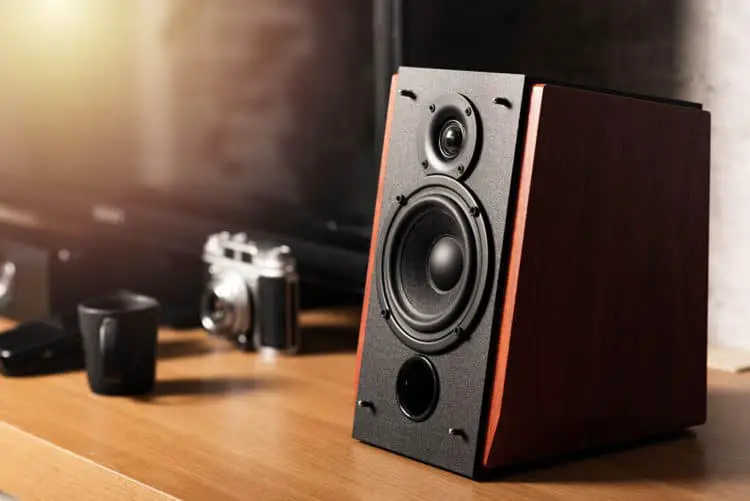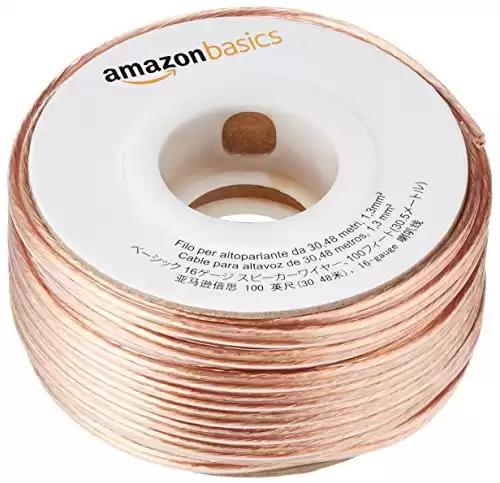Coaxial (Coax) cable is familiar because it’s what gets used to connect your satellite or cable TV to your television. Although we use it primarily for video applications, it is a remarkably versatile product.
It does have some flexibility issues that can limit its applications. Coax is also thicker than what you’re used to using for most speakers, which means tight installations might not benefit from using this product.
Here’s the good news: if you want to improve your sound quality, a coaxial cable is a reasonable choice.
How Do You Connect Coaxial Cable to Speakers?
If you want to connect coaxial cable to your speakers or audio equipment, you must strip the coax of its connectors. After measuring how much wire you’ll need, cut the product to its appropriate length. You’ll also need to remove the insulation and wire shielding to finish the job.
Coaxial cable is arguably one of the most critical inventions humanity has ever produced.
This electrical cable features an inner conductor, a concentric shield, and insulating material that separates them from each other.
It’s called a “coaxial” cable because of how the conductor and shield share a geometric axis with the design.
We typically use coax cable as a transmission line because it carries high-frequency signals with minimal loss.
That’s why it would become the first transatlantic cable installation that we put together in 1858 (!), even though the science behind this technology wasn’t fully described until 1880.
The first patent issued for coaxial cable was also published in Britain in 1880, officially awarding the invention to physicist Oliver Heaviside.
Since it is a transmission line, we can use coax in several applications where high-frequency electrical signals are needed to send information.
Today, you’ll see it used for high-speed broadband Internet installations, telephone trunk lines, cable television distribution, radio transmitter connections, antenna receivers, and data busses.
You can also use some spare coaxial cable to connect your speakers if you want a high-quality audio performance.
Since losses are minimal, all it takes is a few changes to the setup process to use this product as a better wire in some situations.
■ Why Don’t More People Use Coaxial Cable for Their Speakers?
The problem with using coaxial cable for your speakers is that the impedance load can bring inappropriate amperage to your unit.
Whether you’re using an audio monitor on the stage or setting up a fantastic home stereo system at home, the resistance in this setup most receives careful monitoring.
If you drive your audio setup too hard with coax, you can end up blowing things out. If the volume or frequencies are severe, you can even break the speakers!
The best way to reduce this risk is to limit the coaxial cable’s length for your speaker setup. As long as you stay within the standard 40 Hz to 20 kHz range, you’re typically safe with moderate volumes and minimal length.
It also takes more work to prepare coaxial cable to serve as speaker wiring. Since you must cut off the F-connectors on the product, some tools are needed to finish the job.
If you already have them or don’t mind investing in them, you can have an excellent outcome develop!
■ What Is the Sound like in Speakers That Use Coaxial Cable?
The sound you receive when using a coaxial cable is hit-or-miss for the average person. For those who tend to prefer it, the audio quality feels close to a digital replication of vinyl.
You’ll get that warm interference that generates mellow tones with a slight thinness in the mid-range that can make some voices or sounds tinny.
If you’ve ever listened to an audio recording of Louis Armstrong on the trumpet, that’s the idea of what it’ll be like to listen to your favorite songs, tracks, or files across coaxial cable.
Since this sound isn’t 100% authentic because of how the frequencies get routed from the source to the speaker, some people prefer using Hi-Fi cabling instead.
As long as you prepare the coaxial cable for the connection correctly, you should receive an outcome that you’ll enjoy.
Since it does take some work to prepare the coax, you’ll want to set aside an afternoon to complete this task the first time it’s attempted.
How to Use Coaxial Cable as Speaker Wiring
The average person knows how to route a coaxial cable from their wall outlet to their television.
You must screw the F-connectors to each point, ensuring that the cable portion that sticks out gets inserted correctly into each component.
If your speakers have this connection, the process is 100% the same. You’ll route the coax between the two ports and be listening to your favorite songs in seconds.
A growing number of speakers and home audio systems are adding this port to their designs, but it is still relatively rare (and often expensive!) to get this convenience.
That’s why you’ll need to follow these preparation steps to connect your speakers via coaxial cable.
■ Tasks to Complete When Preparing Coaxial Cable for Speaker Wiring
| Remove the connectors from the coaxial cable. | • Most coax products come with dual connections on each side of the line. This design routes the signal from the source to the end product. • You can remove them by cutting through the ends with a sharp utility blade or thick wire cutters. • If you have thick cabling, it might be necessary to remove the shielding layer first. |
| Measure the distance from the source to the speaker. | • When you shop for coaxial cable today, you’ll discover that it typically comes in six-foot increments. • If you want to use this product for speaker connections, you’ll want to get at least one additional length for your primary routing. • It also helps to have a separate length for each speaker connection you must create with it. • Always follow the principle of measuring twice and cutting once to reduce errors. |
| Strip the outer insulation jacket from the coax. | • You’ll want to have a ringing tool available for finishing this step of the coax preparation process. • Once you adjust the blade depth to the appropriate size, you’ll quickly take the jacket off of the product. • You’ll need one built for coaxial cable specifically to have a successful result. • Please don’t use other wire strippers for this task. |
| Unbraid the shielding that protects the inner wire. | • Once you have the insulation off from the coaxial cable, you can start unbraiding the copper wire that protects the internal line. • This woven protectant is also usable for wiring other components, including the audio signal that goes from your system to your speakers. |
| Remove the insulator from around the inner wire. | • At this point, you’re left with the final insulator and the inner wire from the coax. • Once you get rid of that last piece, you’ll have the flexibility needed to have a successful outcome. |
If you have RG-6 coaxial cable at home, you’ll have a steel wire shield to unbraid instead of a copper one.
You’ll want to recycle this product appropriately since it isn’t as useful for replacement wiring.
Why Do I Need to Strip the Entire Coaxial Cable?
You’ll want a coaxial cable ringing tool for stripping the entire wire in most situations. If you only use the end connections, there won’t be as much flexibility for your installation.
When you have a straight-line installation to complete, you could avoid the work of stripping the entire coax since the flexibility is no longer needed.
You can bypass the steps above in that situation to implement the following solution.
- Remove the F-connectors from both ends of your coaxial cable.
- Strip approximately two inches of insulation, braiding, and the final insulator away from the inner wire.
- You’ll need a minimum of 1.5 inches of clearance on both ends to ensure the cable can stay secure.
The issue with this setup is the cable’s weight. If you have one of the thicker coax versions, the product can pull itself out of your speaker’s connectors.
How to Form Speaker Connections with Coaxial Cable
After you’ve secured the inner cable and the braided copper shield, you’re ready to use the coaxial cable to connect your speakers.
You’ll want to take the inner wire and place it within the positive (red) speaker connection. Route it to the system, where you’ll put it in the same connector.
You should have a positive-to-positive connection now. You’ll want to repeat this process for the negative (black) speaker connections, but you are using the copper braided wire for this step.
If your speaker or sound system doesn’t have color designations, look for the “+” and “-“ signs on the unit.
Once you have all of the connections secured, you should be hearing audio come from your speakers. Congratulations! You’ve successfully recycled your coax into a usable product.
A Final Thought about Using Coaxial Cable for Speakers
Although you can use coaxial cable successfully for your speakers and sound system, it’s not always the best idea.
If you have a high-quality setup where the audio signals follow specific processes, coax wiring doesn’t provide the full Hertz spectrum you want for music, broadcasts, and more.
That’s not to say the audio will sound terrible. For the average playlist, you’ll get enough frequencies filled to have everyone enjoy a full-room presentation.
When you include the copper braided wire into the mix, the sounds are above-average when deployed.
When nice isn’t good enough for your listening enjoyment, I highly recommend using a dedicated speaker cable.
The AmazonBasics 16-Gauge speaker wire cable delivers an excellent result for your entire room.
You’ll get spools of 100 feet each to wire the most extensive systems, with each one marked with a white line to ensure you have the polarity information needed for a proper installation.
You’ll get the 16-gauge wire on a hard spool that unwinds comfortably, allowing you to make fast work of your speaker setup.
With the plastic jacket around the wire, you’ll experience less distortion while eliminating all of the steps needed to transform coax into a usable product.
There can be times when the mellow sounds from coaxial cable make sense to have for your speakers or audio setup.
If you prefer a low-fi approach, this combination provides an impressive result!
When your goal is to get pure sounds that deliver authentic outcomes and a balanced EQ, it’s better to use a dedicated speaker wire cable instead of coax.


